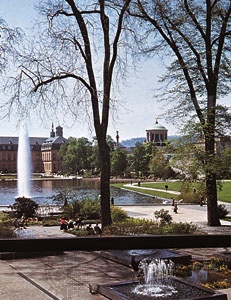Stuttgart
Arkansas, United States
city, northern district seat of Arkansas county (the southern seat is De Witt), east-central Arkansas, U.S., about 50 miles (80 km) southeast of Little Rock. Settled in 1878 by Lutheran minister Adam Buerkle (born in Stuttgart, Germany) and his congregation, the city was incorporated in 1889, raised to a city of the second class in 1897, and to that of the first class in 1917. Stuttgart has long been an agricultural and trading centre and the growing, processing, packaging, and marketing of rice is the mainstay of the economy; other locally produced crops include soybeans, wheat, and oats. Cattle and fish production are also important, as is the manufacture of heating and cooling equipment. Biotechnology is of increasing significance, with several research facilities (conducting studies on fish, rice, cotton, and soybeans) in the vicinity. White River National Wildlife Refuge is 28 miles (45 km) southeast. Stuttgart is well known for its duck hunting, notably at Bayou Meto Wildlife Management Area, about 15 miles (24 km) southwest. Pop. (1990) 10,420; (2000) 9,745.
Germany
 city, capital of Baden-Württemberg Land (state), southwestern Germany. Astride the Neckar River, in a forested vineyard-and-orchard setting in historic Swabia, Stuttgart lies between the Black Forest to the west and the Swabian Alp to the south. There were prehistoric settlements and a Roman fort in the area of Bad Cannstatt (a suburb), but Stuttgart itself originated as a Stuotgarten, a Gestüt, or stud farm, set up about 950. A wine industry developed, and Stuttgart received civic rights after passing to the counts of Württemberg in the 13th century. It became the principal residence of the counts about 1320, and after 1482 it was successively the capital of the Württemberg county, duchy, kingdom, and state. Prosperity in the 16th century was followed by a decline during the Thirty Years' War (1618–48) and the French invasions of Louis XIV (1681–84), from which it did not recover until the Industrial Revolution in the 19th century caused rapid expansion.
city, capital of Baden-Württemberg Land (state), southwestern Germany. Astride the Neckar River, in a forested vineyard-and-orchard setting in historic Swabia, Stuttgart lies between the Black Forest to the west and the Swabian Alp to the south. There were prehistoric settlements and a Roman fort in the area of Bad Cannstatt (a suburb), but Stuttgart itself originated as a Stuotgarten, a Gestüt, or stud farm, set up about 950. A wine industry developed, and Stuttgart received civic rights after passing to the counts of Württemberg in the 13th century. It became the principal residence of the counts about 1320, and after 1482 it was successively the capital of the Württemberg county, duchy, kingdom, and state. Prosperity in the 16th century was followed by a decline during the Thirty Years' War (1618–48) and the French invasions of Louis XIV (1681–84), from which it did not recover until the Industrial Revolution in the 19th century caused rapid expansion.Stuttgart is an important rail junction on the natural route connecting the Danube River with northern Germany and the Rhine River. It is the centre of the largest industrial zone in southwestern Germany and holds various trade fairs and congresses. Although the manufacturing sector has declined, electrical engineering and motor-vehicle and machine construction are still of primary importance, and textiles, clothing, precision instruments (cameras, optical equipment), beer, luxury wooden and leather goods, musical instruments, chemicals, and foodstuffs are produced. Stuttgart also has a port (opened 1958) and has become an important business-service centre. The city is well known as a book centre and has numerous printing works and publishing houses. One of the largest wine-producing communes (groups of growers who bring their grapes to a central location for processing and distribution) in Germany, it has an extensive wine and fruit trade. Stuttgart also has an international airport.
The city centre was almost completely destroyed during World War II, and the rebuilt city has a mix of modern and historic architecture. Historic buildings include the old castle (13th century; rebuilt 1553–78), housing the Landesmuseum; the new palace (1746–1807); the Rosenstein Palace (1824–29), now the natural history museum; the Gothic Leonhardskirche (1463–74), of the hall type; and the Stiftskirche (collegiate church), a 12th-century Romanesque basilica completed in the Gothic style (1436–95). Outside the city centre are Solitude Palace (1763–67) to the west, and Hohenheim Palace (1768–85) to the south, now occupied by Hohenheim University. Examples of modern architecture include the Weissenhof Estate (1927), the town hall (1954–56), the 633-foot (193-metre) television tower (1955), and Stuttgarter Liederhall (concert and congress hall, built 1954–56).
Stuttgart is the seat of Hohenheim University (founded 1818), Stuttgart University (founded 1829), and the Stuttgart Institute of Management and Technology (founded 1998). The city contains technological colleges, a number of prestigious research centres, and academies for art, music, and architecture. It also features the state art gallery, archives, library, observatory, opera, and ballet and the Wilhelma Botanical and Zoological Gardens. The Mercedes-Benz Museum is in the suburb of Untertürkheim. The suburbs of Bad Cannstatt and Berg are health centres with many mineral springs, from which are exported bottled mineral water, and the famous Cannstatter Folk Festival is held in the Cannstatt Meadows every autumn. Pop. (2003 est.) city, 589,161; (2000 est.) urban aggl., 2,672,000.
- Yucca House National Monument
- yucca moth
- Yu Dafu
- Yudenich, Nikolay
- Yue
- Yue Fei
- yuefu
- yueqin
- Yueyang
- Yuezhi
- yuga
- Yu-Gi-Oh!
- Yugoslavia
- Yugoslavia, flag of
- Yui Shōsetsu
- Yukaghir
- Yukaghir language
- yukata
- Yukawa Hideki
- Yuki
- Yukon
- Yukon-Charley Rivers National Preserve
- Yukon, flag of
- Yukon River
- Yul Brynner